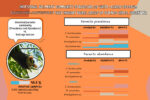Intestinal helminth community structure of white-eared opossum (Didelphis albiventris) that inhabit rural areas of Buenos Aires, Argentina
Gimena Illia, Isabel Gómez Villafañe, M. Cecilia Ezquiaga, Guillermo H. Cassini, A. Cecilia GozziThe white-eared opossum (Didelphis albiventris) is a neotropical marsupial that inhabits various ecoregions and highly modified environments. However, there is limited research on host-parasite interactions and the structure of helminth communities in D. albiventris. Therefore, the aim of this study is to investigate the intestinal helminths of D. albiventris inhabiting a rural area in Buenos Aires, Argentina, and assess the relationship between host age and sex, and helminth community structure. Opposums were captured in 2004 and intestines were examined to detect helminths. By analyzing 22 intestines, we identified a total of 8 978 helminths, including Cruzia tentaculata, Turgida turgida, Rhopalias coronatus, Brachylaima sp., individuals of the family Diplostomidae, and a single specimen of a cestode. Among these, C. tentaculata and R. coronatus were the most prevalent species, with C. tentaculata exhibiting the highest levels of abundance, mean intensity, and aggregation index. To assess the influence of host sex and age on parasite abundance and probability of occurrence, we conducted Generalized Linear Models. The results revealed that host juveniles had lower helminth prevalence and abundance compared to other age categories. Host sex was only significant in interaction with host age for parasite abundance in C. tentaculata and R. coronatus. Most captured juveniles relied on maternal feeding, potentially reducing exposure to consuming infected intermediate hosts with indirect life cycles. Understanding the parasite ecology of this opossum species in modified environments provides valuable information about their role at the wildlife-human interface in anthropogenic areas.
Estructura de la comunidad helmíntica intestinal de las comadrejas overas (Didelphis albiventris) que habitan áreas rurales de Buenos Aires, Argentina. La comadreja overa Didelphis albiventris es un marsupial neotropical que habita en diversas ecorregiones, y con frecuencia se halla en ambientes peridomésticos. Si bien existen estudios que describen los parásitos de D. albiventris, los que contemplan asociaciones entre estos y las características intrínsecas del hospedador son escasos. El objetivo de este estudio fue describir los helmintos intestinales de Didelphis albiventris en un área rural de Buenos Aires, y evaluar la influencia del sexo y la edad del hospedador sobre la presencia y abundancia de parásitos. Se analizaron 22 intestinos provenientes de la captura de ejemplares de D. albiventris y se realizaron Modelos Lineales Generalizados. Se hallaron 8 978 helmintos: Cruzia tentaculata, Turgida turgida, Rhopalias coronatus, Brachylaima sp.; familia Diplostomidae y un cestode. Cruzia tentaculata y R. coronatus fueron las especies más prevalentes; de ellas, C. tentaculata presentó mayor abundancia, intensidad media e índice de agregación. Los helmintos hallados son heteroxenos y fueron registrados previamente para esta especie. Los resultados indican que los individuos juveniles poseen una menor presencia y abundancia de helmintos, lo cual estaría asociado a su modo de alimentación. El sexo solo fue significativo en interacción con la edad para la abundancia de C. tentaculata y R. coronatus. Estudiar la estructura de la comunidad parasitaria de D. albiventris y los factores que la determinan proporciona información sobre su papel en el ambiente, particularmente en ambientes modificados, donde la interacción fauna silvestre-humanos es mayor. Futuros estudios que contemplen características ambientales y tamaño corporal del hospedador complementarán los resultados hallados en este estudio.
